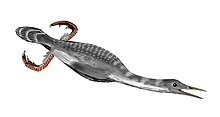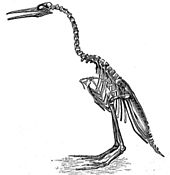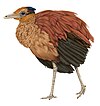黄昏鸟属
| 黄昏鸟 化石时期:晚白垩纪,
| |
|---|---|

| |
| 黄昏鸟骨架 | |
| 科学分类 | |
| 界: | 动物界 Animalia |
| 门: | 脊索动物门 Chordata |
| 科: | †黄昏鸟科 Hesperornithidae |
| 属: | †黄昏鸟属 Hesperornis Marsh, 1872 |
| 模式种 | |
| †王室黄昏鸟 Hesperornis regalis Marsh, 1872
| |
| 种 | |
|
†H. regalis Marsh, 1872 | |
| 异名 | |
|
Lestornis Marsh, 1876 | |
黄昏鸟(学名Hesperornis)是生活于白垩纪(桑托阶-坎帕阶)已经灭绝,而且具有牙齿的鸟类,主要生活在北半球的海域与近海地区,以鱼类及其他海洋生物为主食。
虽然有一些体型较小的种类可能具有飞行能力,但是其他大部分的种类是不具有飞行能力的,因为它们的翅膀已经退化了。一些学者认为黄昏鸟类必须滑动腹部才能在陆地上移动,在岸上的行动显得笨拙,而且因为脚呈现桨状,适合游泳与潜水,所以推测在大部分的时间里,它们很有可能是生活在水中的。
描述[编辑]


黄昏鸟为大型鸟类,体长可达1.8米(5.9英尺)。[2]翅膀几乎退化,依靠强力的后肢游泳。黄昏鸟的脚不带蹼,而是呈现桨状,和现存䴙䴘类似,适合在水中潜泳。
和其他中生代鸟类(例如:鱼鸟)一样,黄昏鸟有喙也具有牙齿,用以咬住固定猎物。黄昏鸟的牙齿生长在上、下颌骨的纵向凹槽中,不具有独立的齿槽,和其他所知的鸟类(包含兽脚类恐龙)的牙齿生长模式不同,但却和沧龙十分类似,属于趋同进化。[3][4]黄昏鸟的牙齿分布在整个下颌骨与上颌骨后半部,前上颌骨与前齿骨不带齿,为其嘴喙。嘴喙坚硬带有角蛋白,和现存鸟类相同。[5]黄昏鸟的上颚带有凹槽,在上下颌闭合时可收合下颚牙齿。[6]另外,黄昏鸟的下颌骨拥有和海王龙类似的可活动双重关节,有助于将猎物完整吞下肚。[4]
发现历史[编辑]

最早的黄昏鸟化石在1871年由奥塞内尔·查利斯·马什与十位学生于美国堪萨斯州发现。[7]当时发现到的化石可以明显看出为一种巨型鸟类,翅膀退化但具有强壮的后脚,却缺乏头颅,马什推断黄昏鸟为一种擅于潜水的鸟类[8]马什将发掘到的新物种命名为“Hesperornis regalis”,意思为“帝王西方鸟”。[9]
在隔了一年后,马什重新组织了考古团队再次回到堪萨斯州,这次由马什的学生Thomas H. Russell发现到了接近完整的黄昏鸟化石。[10]这具样本上完整地保留了黄昏鸟的头部,让马什惊讶的是,黄昏鸟的口中上下均具有牙齿。[11]在1873年,马什表示这些化石的发现,模糊了分隔鸟类与爬虫类的界线。[11]然而之后不久,部分挖掘到的化石样本却流到了爱德华·德林克·科普手上,成为引发“化石战争”的导火线。
大众文化[编辑]
- 出现在BBC的电视节目《海底霸王》(Sea Monsters)第3集,在七大危险之洋中的最危险海洋白垩纪海岸出现。
- 出现在《重返侏罗纪》的第1季第3集中,从奇异点穿越至住宅地下室,袭击前往勘查的屋主。
- 在沙盒动作冒险游戏《方舟:生存进化》中,玩家可以捕捉并驯服黄昏鸟。
外部链接[编辑]
参考文献[编辑]
- ^ Keiichi Aotsuka; Tamaki Sato. Hesperornithiformes (Aves: Ornithurae) from the Upper Cretaceous Pierre Shale, Southern Manitoba, Canada. Cretaceous Research. 2016,. in press. doi:10.1016/j.cretres.2016.03.003.
- ^ Perrins, Christopher. Harrison, C.J.O. , 编. Birds: Their Life, Their Ways, Their World. Pleasantville, NY, US: Reader's Digest Association, Inc. 1987: 165–166 [1979]. ISBN 0895770652.
- ^ Marsh, Othniel Charles (1880): Odontornithes, a Monograph on the Extinct Toothed Birds of North America. Government Printing Office, Washington DC.
- ^ 4.0 4.1 Gregory, Joseph T. The Jaws of the Cretaceous Toothed Birds, Ichthyornis and Hesperornis (PDF). Condor. 1952, 54 (2): 73–88 [2018-06-16]. JSTOR 1364594. doi:10.2307/1364594. (原始内容存档 (PDF)于2021-03-16).
- ^ Heironymus, T.L.; Witmer, L.M. Homology and evolution of avian compound rhamphothecae (PDF). The Auk. 2010, 127 (3): 590–604 [2018-06-16]. doi:10.1525/auk.2010.09122. (原始内容 (PDF)存档于2015-09-24).
- ^ Elzanowski, A. New observations on the skull of Hesperornis with reconstructions of the bony palate and otic region. Postilla. 1991, 207: 1–20.
- ^ Thomson, 191.
- ^ Thomson, 193.
- ^ Holtz, Thomas R. Jr. (2011) Dinosaurs: The Most Complete, Up-to-Date Encyclopedia for Dinosaur Lovers of All Ages, Winter 2010 Appendix. (页面存档备份,存于互联网档案馆)
- ^ Charles Schuchert and Clara Mae LeVene, O.C. Marsh: Pioneer in Paleontology, p. 427. New York: Arno Press, 1978. Later, Russell assisted Marsh while attending medical school; he became a surgeon, professor of Clinical Surgery in the Yale School of Medicine, and Marsh's personal physician until Marsh's death in 1899. See Proceedings of the Connecticut State Medical Society (Google eBook) and Genealogical and Family History of the State of Connecticut: A Record of the Achievements of Her People in the Making of a Commonwealth and the Founding of a Nation. Editorial staff: William Richard Cutter, Edward Henry Clement, Samuel Hart, Mary Kingsbury Talcott, Frederick Bostwick, Ezra Scollay Stearns. Volume I (of 4). New York: Lewis Historical Publishing Company, 1911.
- ^ 11.0 11.1 Wallace, 86.
| ||||||||||||||||||||||||||||||||||||||||||||||||||||||||||||||||||||||||||||||||||||||||||||||||||||||||||||||||||||||||||||||||||||||||||||||||||||||||||||||||||||||||||||||||||||||||||||||||||||||||||||||||||||||||||||||||||||||||||||||||||||||||||||||||||||||||||||||||||||||||||||||||||||||||||||||||||||||||||||||||||||||||||||||||||||||||||||||||||||||||||||||||||||||||||||||||||||||||||||||||||||||||||||||||||||||||||||||||||||||||||||||||||||||||||||||||||||||||||||||||||||||||||||||||||||||||||||||||||||||||||||||||||||||||||||||||||||||||||||||||||||||||||||||||||||||||
|























